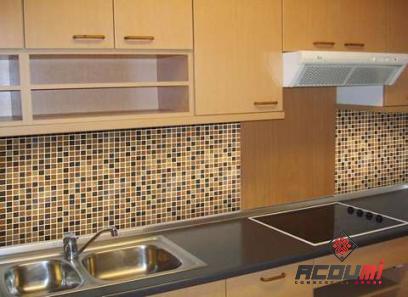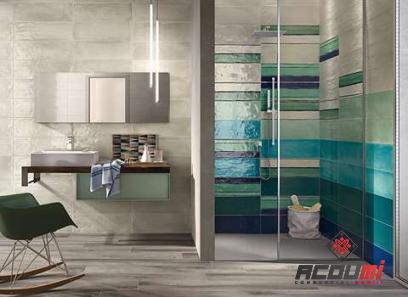When it comes to selecting the perfect tile for your home, the choice between ceramic and porcelain can be a daunting one. Both ceramic and porcelain tiles offer unique benefits and characteristics that make them suitable for various applications within a home. In this article, we will delve deep into the differences between ceramic and porcelain tiles to help you make an informed decision for your next project. Durability is often a key factor to consider when choosing between ceramic and porcelain tiles.

.
 Porcelain tiles are known for their exceptional durability and strength, making them an ideal choice for high-traffic areas such as kitchens and bathrooms. Porcelain tiles are denser and less porous than ceramic tiles, which means they are less likely to absorb moisture and are more resistant to stains, scratches, and chipping. On the other hand, ceramic tiles are also durable and can withstand wear and tear in most residential settings. However, they may not be as resilient as porcelain tiles when exposed to heavy foot traffic or frequent use. When it comes to aesthetics, both ceramic and porcelain tiles offer a wide range of colors, patterns, and textures to suit any design style. Ceramic tiles are typically glazed and come in a variety of finishes, including matte, glossy, and textured. This allows for endless design possibilities and the ability to create a unique look in any space. Porcelain tiles, on the other hand, can mimic the look of natural materials such as stone, wood, or concrete with stunning realism. The color and pattern of porcelain tiles run through the entire thickness of the tile, making them more resistant to fading and wear over time. In terms of maintenance, ceramic and porcelain tiles are both easy to clean and maintain, making them a practical choice for busy households.
Porcelain tiles are known for their exceptional durability and strength, making them an ideal choice for high-traffic areas such as kitchens and bathrooms. Porcelain tiles are denser and less porous than ceramic tiles, which means they are less likely to absorb moisture and are more resistant to stains, scratches, and chipping. On the other hand, ceramic tiles are also durable and can withstand wear and tear in most residential settings. However, they may not be as resilient as porcelain tiles when exposed to heavy foot traffic or frequent use. When it comes to aesthetics, both ceramic and porcelain tiles offer a wide range of colors, patterns, and textures to suit any design style. Ceramic tiles are typically glazed and come in a variety of finishes, including matte, glossy, and textured. This allows for endless design possibilities and the ability to create a unique look in any space. Porcelain tiles, on the other hand, can mimic the look of natural materials such as stone, wood, or concrete with stunning realism. The color and pattern of porcelain tiles run through the entire thickness of the tile, making them more resistant to fading and wear over time. In terms of maintenance, ceramic and porcelain tiles are both easy to clean and maintain, making them a practical choice for busy households.
..
 Both types of tiles can be cleaned with a damp cloth and mild detergent, making them suitable for regular use in kitchens and bathrooms. However, porcelain tiles may require less maintenance over time due to their superior resistance to stains and wear. Additionally, because of their low porosity, porcelain tiles are less likely to harbor bacteria and mold, making them a hygienic choice for wet areas. Another important factor to consider when choosing between ceramic and porcelain tiles is their cost. Porcelain tiles are generally more expensive than ceramic tiles due to their high quality and durability. However, the long-term benefits of porcelain tiles, such as their longevity and low maintenance requirements, can offset the initial investment. Ceramic tiles, on the other hand, are a more budget-friendly option for homeowners looking to achieve a stylish and durable flooring solution without breaking the bank. Installation is another key consideration when choosing between ceramic and porcelain tiles. Both types of tiles can be installed using similar methods, such as thin-set mortar or adhesive. However, porcelain tiles are heavier and denser than ceramic tiles, which may require additional labor and expertise during installation. It is essential to hire a professional tile installer who has experience working with porcelain tiles to ensure a seamless and long-lasting finish. Ceramic tiles, being lighter and easier to work with, may be a more DIY-friendly option for homeowners looking to save on installation costs. When it comes to versatility, both ceramic and porcelain tiles offer endless possibilities for use in various areas of the home. Ceramic tiles are suitable for walls, floors, and backsplashes in kitchens, bathrooms, and living spaces. Their wide range of styles and finishes make them a versatile choice for nearly any design aesthetic. Porcelain tiles, with their superior durability and resistance to moisture, are an excellent option for outdoor applications such as patios, decks, and pool surrounds. They can also be used in commercial settings where high traffic and durability are essential. In conclusion, the choice between ceramic and porcelain tiles ultimately comes down to your specific needs, budget, and design preferences. Porcelain tiles are a premium option for homeowners seeking superior durability, longevity, and low maintenance. Ceramic tiles, on the other hand, offer a cost-effective solution for achieving a stylish and practical flooring or wall covering.
Both types of tiles can be cleaned with a damp cloth and mild detergent, making them suitable for regular use in kitchens and bathrooms. However, porcelain tiles may require less maintenance over time due to their superior resistance to stains and wear. Additionally, because of their low porosity, porcelain tiles are less likely to harbor bacteria and mold, making them a hygienic choice for wet areas. Another important factor to consider when choosing between ceramic and porcelain tiles is their cost. Porcelain tiles are generally more expensive than ceramic tiles due to their high quality and durability. However, the long-term benefits of porcelain tiles, such as their longevity and low maintenance requirements, can offset the initial investment. Ceramic tiles, on the other hand, are a more budget-friendly option for homeowners looking to achieve a stylish and durable flooring solution without breaking the bank. Installation is another key consideration when choosing between ceramic and porcelain tiles. Both types of tiles can be installed using similar methods, such as thin-set mortar or adhesive. However, porcelain tiles are heavier and denser than ceramic tiles, which may require additional labor and expertise during installation. It is essential to hire a professional tile installer who has experience working with porcelain tiles to ensure a seamless and long-lasting finish. Ceramic tiles, being lighter and easier to work with, may be a more DIY-friendly option for homeowners looking to save on installation costs. When it comes to versatility, both ceramic and porcelain tiles offer endless possibilities for use in various areas of the home. Ceramic tiles are suitable for walls, floors, and backsplashes in kitchens, bathrooms, and living spaces. Their wide range of styles and finishes make them a versatile choice for nearly any design aesthetic. Porcelain tiles, with their superior durability and resistance to moisture, are an excellent option for outdoor applications such as patios, decks, and pool surrounds. They can also be used in commercial settings where high traffic and durability are essential. In conclusion, the choice between ceramic and porcelain tiles ultimately comes down to your specific needs, budget, and design preferences. Porcelain tiles are a premium option for homeowners seeking superior durability, longevity, and low maintenance. Ceramic tiles, on the other hand, offer a cost-effective solution for achieving a stylish and practical flooring or wall covering.
…
 By considering factors such as durability, aesthetics, maintenance, cost, installation, and versatility, you can make an informed decision when selecting the perfect tile for your home. Whether you choose ceramic or porcelain, both types of tiles are sure to enhance the beauty and functionality of your living space for years to come. In addition to the practical considerations mentioned above, it’s important to note the environmental impact of ceramic and porcelain tiles. Both types of tiles are made from natural materials such as clay and minerals, making them eco-friendly choices for sustainable construction and renovation projects. Ceramic tiles are typically fired at lower temperatures than porcelain tiles, resulting in a lower carbon footprint during the manufacturing process. Additionally, both ceramic and porcelain tiles are recyclable and can be repurposed for other projects, reducing waste and promoting a circular economy. When it comes to choosing between ceramic and porcelain tiles for your home, it’s essential to consider the needs and priorities of your specific project. If you prioritize durability, longevity, and low maintenance, porcelain tiles may be the ideal choice for high-traffic areas and outdoor applications. On the other hand, if you are looking for a budget-friendly option with a wide range of design possibilities, ceramic tiles can offer a stylish and practical solution for walls, floors, and backsplashes. Before making your final decision, it’s recommended to consult with a professional tile installer or designer to determine the best type of tile for your specific needs and design goals. They can provide valuable insights and recommendations based on your project requirements, budget constraints, and aesthetic preferences. By working with a knowledgeable expert, you can ensure that your tile installation is carried out with precision and care, resulting in a beautiful and functional finish that will stand the test of time. In conclusion, whether you choose ceramic or porcelain tiles for your home, both options offer unique benefits and characteristics that can enhance the beauty and functionality of your living space. From durability and aesthetics to maintenance and cost, there are many factors to consider when selecting the perfect tile for your project. By weighing these factors carefully and taking into account your specific needs and preferences, you can make an informed decision that will bring lasting value and enjoyment to your home for years to come.
By considering factors such as durability, aesthetics, maintenance, cost, installation, and versatility, you can make an informed decision when selecting the perfect tile for your home. Whether you choose ceramic or porcelain, both types of tiles are sure to enhance the beauty and functionality of your living space for years to come. In addition to the practical considerations mentioned above, it’s important to note the environmental impact of ceramic and porcelain tiles. Both types of tiles are made from natural materials such as clay and minerals, making them eco-friendly choices for sustainable construction and renovation projects. Ceramic tiles are typically fired at lower temperatures than porcelain tiles, resulting in a lower carbon footprint during the manufacturing process. Additionally, both ceramic and porcelain tiles are recyclable and can be repurposed for other projects, reducing waste and promoting a circular economy. When it comes to choosing between ceramic and porcelain tiles for your home, it’s essential to consider the needs and priorities of your specific project. If you prioritize durability, longevity, and low maintenance, porcelain tiles may be the ideal choice for high-traffic areas and outdoor applications. On the other hand, if you are looking for a budget-friendly option with a wide range of design possibilities, ceramic tiles can offer a stylish and practical solution for walls, floors, and backsplashes. Before making your final decision, it’s recommended to consult with a professional tile installer or designer to determine the best type of tile for your specific needs and design goals. They can provide valuable insights and recommendations based on your project requirements, budget constraints, and aesthetic preferences. By working with a knowledgeable expert, you can ensure that your tile installation is carried out with precision and care, resulting in a beautiful and functional finish that will stand the test of time. In conclusion, whether you choose ceramic or porcelain tiles for your home, both options offer unique benefits and characteristics that can enhance the beauty and functionality of your living space. From durability and aesthetics to maintenance and cost, there are many factors to consider when selecting the perfect tile for your project. By weighing these factors carefully and taking into account your specific needs and preferences, you can make an informed decision that will bring lasting value and enjoyment to your home for years to come.










Your comment submitted.